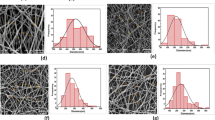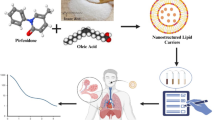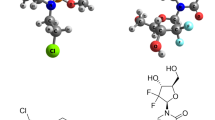Abstract
Aim:
To prepare a biodegradable polymeric carrier for oral delivery of a water-insoluble drug capsaicin (CAP) and evaluate its quality.
Methods:
CAP-loaded methoxy poly (ethylene glycol)-poly(ε-caprolactone) nanoparticles (CAP/NPs) were prepared using a modified emulsification solvent diffusion technique. The quality of CAP/NPs were evaluated using transmission electron microscopy, powder X-ray diffraction, differential scanning calorimetry and Fourier transform infrared techniques. A dialysis method was used to analyze the in vitro release profile of CAP from the CAP/NPs. Adult male rats were orally administered CAP/NPs (35 mg/kg), and the plasma concentrations of CAP were measured with a validated HPLC method. The morphology of rat gastric mucosa was studied with HE staining.
Results:
CAP/NPs had an average diameter of 82.54±0.51 nm, high drug-loading capacity of 14.0%±0.13% and high stability. CAP/NPs showed a biphasic release profile in vitro: the burst release was less than 25% of the loaded drug within 12 h followed by a more sustained release for 60 h. The pharmacokinetics study showed that the mean maximum plasma concentration was observed 4 h after oral administered of CAP/NPs, and approximately 90 ng/mL of CAP was detected in serum after 36 h. The area under the curve for the CAP/NPs group was approximately 6-fold higher than that for raw CAP suspension. Histological studies showed that CAP/NPs markedly reduced CAP-caused gastric mucosa irritation.
Conclusion:
CAP/NPs significantly enhance the bioavailability of CAP and markedly reduce gastric mucosa irritation in rats.
Similar content being viewed by others
Log in or create a free account to read this content
Gain free access to this article, as well as selected content from this journal and more on nature.com
or
References
Tavano L, Alfano P, Muzzalupo R, de Cindio B . Niosomes vs microemulsions: New carriers for topical delivery of Capsaicin. Colloids Surf B Biointerfaces 2011; 87: 333–9.
Huang YB, Lin YH, Lu TM, Wang RJ, Tsai YH, Wu PC . Transdermal delivery of capsaicin derivative-sodium nonivamide acetate using microemulsions as vehicles. Int J Pharm 2008; 349: 206–11.
Lee SH, Richardson RL, Dashwood RH, Baek SJ . Capsaicin represses transcriptional activity of β-catenin in human colorectal cancer cells. J Nutr Biochem 2012; 23: 646–55.
Mori A, Lehmann S, O'Kelly J, Kumagai T, Desmond JC, Pervan M, et al. Capsaicin, a component of red peppers, inhibits the growth of androgen-independent, p53 mutant prostate cancer cells. Cancer Res 2006; 66: 3222–9.
Zamani S, Khoee S . Preparation of core-shell chitosan/PCL-PEG triblock copolymer nanoparticles with ABA and BAB morphologies: Effect of intraparticle interactions on physicochemical properties. Polymer 2012; 53: 5723–36.
Lu F, Lei L, Shen YY, Hou JW, Chen WL, Li YG, et al. Effects of amphiphilic PCL-PEG-PCL copolymer addition on 5-fluorouracil release from biodegradable PCL films for stent application. Int J Pharm 2011; 419: 77–84.
Tanaka K, Kanazawa T, Shibata Y, Suda Y, Fukuda T, Takashima Y, et al. Development of cell-penetrating peptide-modified MPEG-PCL diblock copolymeric nanoparticles for systemic gene delivery. Int J Pharm 2010; 396: 229–38.
Endres TK, Beck-Broichsitter M, Samsonova O, Renette T, Kissel TH . Self-assembled biodegradable amphiphilic PEG-PCL-lPEI triblock copolymers at the borderline between micelles and nanoparticles designed for drug and gene delivery. Biomaterials 2011; 32: 7721–31.
Wilson DR, Zhang N, Silvers AL, Forstner MB, Bader RA . Synthesis and evaluation of cyclosporine A-loaded polysialic acid-polycaprolactone micelles for rheumatoid arthritis. Eur J Pharm Sci 2014; 51: 146–56.
Zhang H, Wilson J, Zhang J, Luo Y . Characterization of potential degradation products in a PEGylating reagent 20 kDa monomethoxy polyethylene glycol propionaldehyde by RP-HPLC, APCI-MS and NMR. J Pharm Biomed Anal 2014; 89: 221–6.
Jiang X, Xin H, Sha X, Gu J, Jiang Y, Law K, et al. PEGylated poly(trimethylene carbonate) nanoparticles loaded with paclitaxel for the treatment of advanced glioma: In vitro and in vivo evaluation. Int J Pharm 2011; 420: 385–94.
Zhang Y, Zhang Q, Zha L, Yang W, Wang C, Jiang X, et al. Preparation, characterization and application of pyrene-loaded methoxy poly(ethylene glycol)-poly(lactic acid) copolymer nanoparticles. Colloid Polym Sci 2004; 282: 1323–8.
Han HS, Lee J, Kim HR, Chae SY, Kim M, Saravanakumar G, et al. Robust PEGylated hyaluronic acid nanoparticles as the carrier of doxorubicin: Mineralization and its effect on tumor targetability in vivo. J Control Release 2013; 168: 105–14.
Wei K, Peng X, Zou F . Folate-decorated PEG-PLGA nanoparticles with silica shells for capecitabine controlled and targeted delivery. Int J Pharm 2014; 464: 225–33.
Parmar N, Singla N, Amin S, Kohli K . Study of cosurfactant effect on nanoemulsifying area and development of lercanidipine loaded (SNEDDS) self nanoemulsifying drug delivery system. Colloids Surf B Biointerfaces 2011; 86: 327–38.
Li TSC, Yawata T, Honke K . Efficient siRNA delivery and tumor accumulation mediated by ionically cross-linked folic acid-poly(ethylene glycol)-chitosan oligosaccharide lactate nanoparticles: For the potential targeted ovarian cancer gene therapy. Eur J Pharm Sci 2014; 52: 48–61.
Mohanty C, Sahoo SK . The in vitro stability and in vivo pharmacokinetics of curcumin prepared as an aqueous nanoparticulate formulation. Biomaterials 2010; 31: 6597–611.
Das RK, Kasoju N, Bora U . Encapsulation of curcumin in alginate-chitosan-pluronic composite nanoparticles for delivery to cancer cells. Nanomedicine 2010; 6: 153–60.
De Baere S, Eeckhaut V, Steppe M, De Maesschalck C, De Backer P, Van Immerseel F, et al. Development of a HPLC-UV method for the quantitative determination of four short-chain fatty acids and lactic acid produced by intestinal bacteria during in vitro fermentation. J Pharm Biomed Anal 2013; 80: 107–15.
Yu JN, Zhu Y, Wang L, Peng M, Tong SS, Cao X, et al. Enhancement of oral bioavailability of the poorly water-soluble drug silybin by sodium cholate/phospholipid-mixed micelles. Acta Pharmacol Sin 2010; 31: 759–64.
Chu C, Tong SS, Xu Y, Wang L, Fu M, Ge YR, et al. Proliposomes for oral delivery of dehydrosilymarin: preparation and evaluation in vitro and in vivo. Acta Pharmacol Sin 2011; 32: 973–80.
Uppoor VRS . Regulatory perspectives on in vitro (dissolution)/in vivo (bioavailability) correlations. J Control Release 2001; 72: 127–32.
Xie W, Zhu W, Shen Z . Synthesis, isothermal crystallization and micellization of mPEG-PCL diblock copolymers catalyzed by yttrium complex. Polymer 2007; 48: 6791–8.
Cai R, Li R, Qian J, Xie A, Nie K . The morphology and fabrication of nanostructured micelle by a novel block copolymer with linear-dendritic structure. Mater Sci Eng C Mater Biol Appl 2013; 33: 2070–7.
Zi P, Yang X, Kuang H, Yang Y, Yu L . Effect of HPβCD on solubility and transdermal delivery of capsaicin through rat skin. Int J Pharm 2008; 358: 151–8.
Shah V, Midha K, Findlay JA, Hill H, Hulse J, McGilveray I, et al. Bioanalytical method validation — a revisit with a decade of progress. Pharm Res 2000; 17: 1551–7.
Chakraborty S, Shukla D, Mishra B, Singh S . Lipid — An emerging platform for oral delivery of drugs with poor bioavailability. Eur J Pharm Biopharm 2009; 73: 1–15.
Lu Y, Kim S, Park K . In vitro–in vivo correlation: Perspectives on model development. Int J Pharm 2011; 418: 142–8.
Dash TK, Konkimalla VB . Poly-є-caprolactone based formulations for drug delivery and tissue engineering: A review. J Control Release 2012; 158: 15–33.
Xing F, Cheng G, Yi K, Ma L . Nanoencapsulation of capsaicin by complex coacervation of gelatin, acacia, and tannins. J Appl Polymer Sci 2005; 96: 2225–9.
Tyagi P, Chancellor MB, Li Z, de Groat WC, Yoshimura N, Fraser MO, et al. Urodynamic and immunohistochemical evaluation of intravesical capsaicin delivery using thermosensitive hydrogel and liposomes. J Urol 2004; 171: 483–9.
Rao JP, Geckeler KE . Polymer nanoparticles: Preparation techniques and size-control parameters. Prog Polymer Sci 2011; 36: 887–913.
Zhang Z, Feng SS . The drug encapsulation efficiency, in vitro drug release, cellular uptake and cytotoxicity of paclitaxel-loaded poly(lactide)-tocopheryl polyethylene glycol succinate nanoparticles. Biomaterials 2006; 27: 4025–33.
Gu C, Le V, Lang M, Liu J . Preparation of polysaccharide derivates chitosan-graft-poly(ε-caprolactone) amphiphilic copolymer micelles for 5-fluorouracil drug delivery. Colloids Surf B Biointerfaces 2014; 116: 745–50.
Danhier F, Feron O, Préat V . To exploit the tumor microenvironment: Passive and active tumor targeting of nanocarriers for anti-cancer drug delivery. J Control Release 2010; 148: 135–46.
Bernabeu E, Helguera G, Legaspi MJ, Gonzalez L, Hocht C, Taira C, et al. Paclitaxel-loaded PCL-TPGS nanoparticles: In vitro and in vivo performance compared with Abraxane®. Colloids Surf B Biointerfaces 2014; 113: 43–50.
Knolle E, Zadrazil M, Kovacs GG, Medwed S, Scharbert G, Schemper M . Comparison of cooling and EMLA to reduce the burning pain during capsaicin 8% patch application: A randomized, double-blind, placebo-controlled study. Pain 2013; 154: 2729–36.
Acknowledgements
This work was supported by the National Natural Science Foundation of China (30973677), National “Twelfth Five-Year” Plan for Science & Technology Support (2012BAD36B01), the Doctoral Fund of Ministry of Education of China (20113227110012), Special Funds for 333 (BRA2013198) and 331 Projects and Industry-University-Research Institution Cooperation (JHB2012-37, GY2012049, and GY2011028) in Jiangsu Province and Zhenjiang City. The authors also thank the Jiangsu University Ethics Committee for their guidance in the animal experiments.
Author information
Authors and Affiliations
Corresponding authors
Rights and permissions
About this article
Cite this article
Peng, W., Jiang, Xy., Zhu, Y. et al. Oral delivery of capsaicin using MPEG-PCL nanoparticles. Acta Pharmacol Sin 36, 139–148 (2015). https://doi.org/10.1038/aps.2014.113
Received:
Accepted:
Published:
Issue date:
DOI: https://doi.org/10.1038/aps.2014.113
Keywords
This article is cited by
-
Post-synthesis nanostructuration of BSA-Capsaicin nanoparticles generated by sucrose excipient
Scientific Reports (2021)
-
Exploring the Neuroprotective Potential of Rosiglitazone Embedded Nanocarrier System on Streptozotocin Induced Mice Model of Alzheimer’s Disease
Neurotoxicity Research (2021)
-
Encapsulation of clozapine into polycaprolactone nanoparticles as a promising strategy of the novel nanoformulation of the active compound
Journal of Nanoparticle Research (2019)
-
Polymer type and molecular weight dictate the encapsulation efficiency and release of Quercetin from polymeric micelles
Colloid and Polymer Science (2017)



